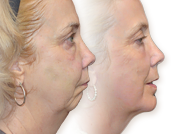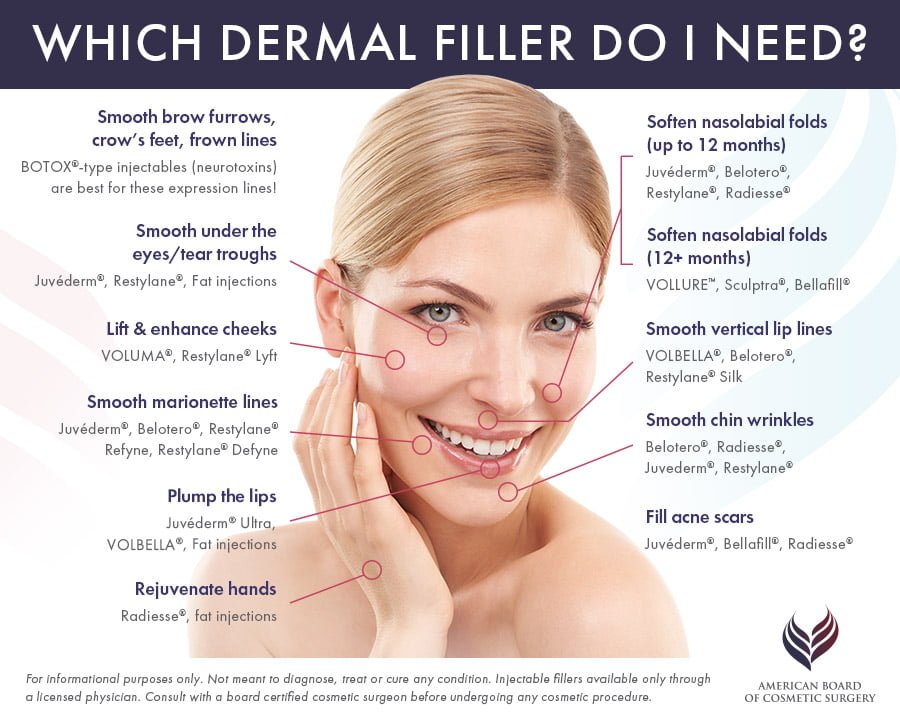What are Injectable Dermal Fillers?
Dermal fillers are gel-like substances that are injected beneath the skin to restore lost volume, smooth lines and soften creases, or enhance facial contours. More than 1 million men and women annually choose this popular facial rejuvenation treatment, which can be a cost-effective way to look younger without surgery or downtime.
- How can dermal fillers enhance my appearance?
- What are fillers made with?
- Choosing a provider
- Which filler do I need?
- What to expect during treatment
- How long will results last?
- Find a qualified dermal filler provider
How Can Dermal Fillers Enhance My Appearance?
While dermal fillers are casually known as “wrinkle fillers,” they can do much more than just smooth out wrinkles, although they are excellent at this too! Here are a few of the common issues dermal fillers can help address:
- Smooth out lines around nose and mouth (a.k.a. marionette lines, smile lines, and parentheses)
- Enhance & restore volume to sunken cheeks or temples
- Diminish vertical lip lines
- Plump & enhance the lips
- Smooth out a chin crease
- Improve symmetry among facial features
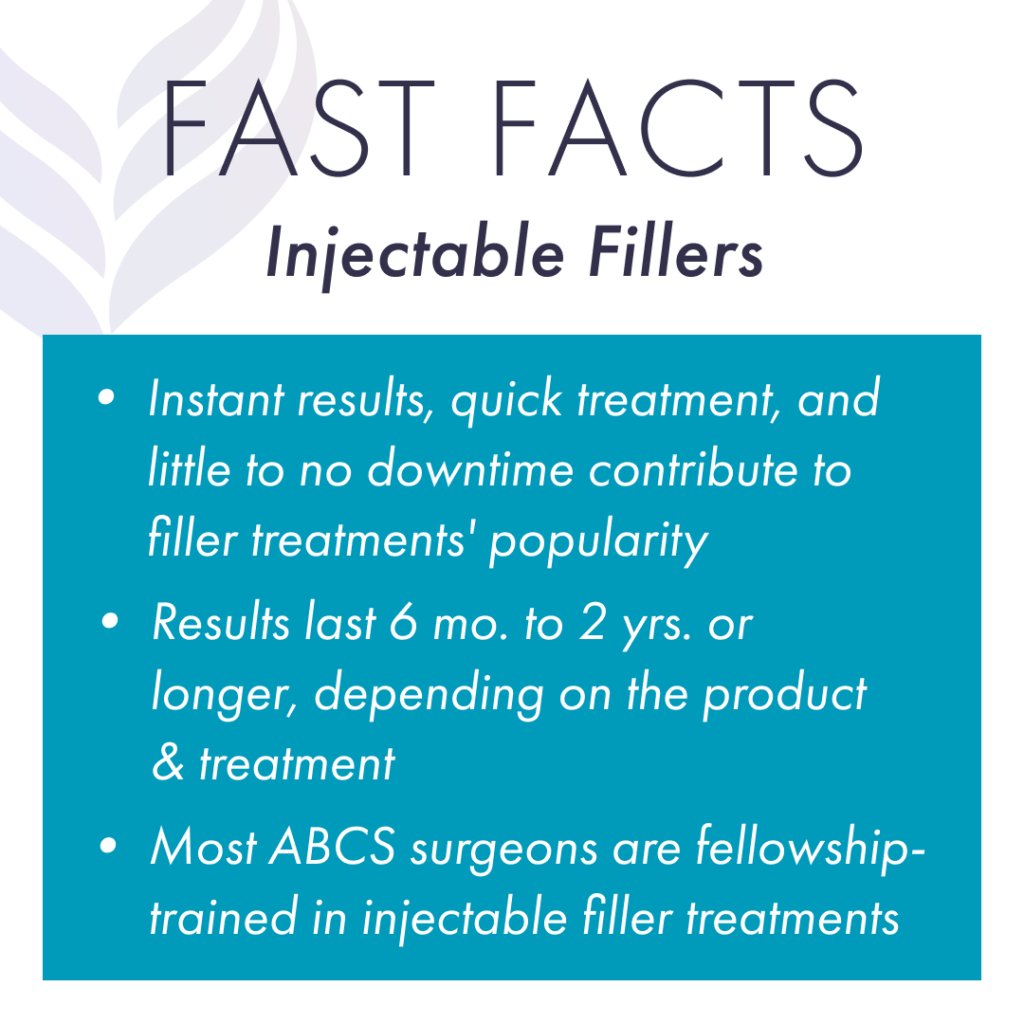
- Key Benefits
- Glossary
- Adds volume to face: Injectable fillers can add volume to various areas of the face, such as the cheeks, lips, and under the eyes, creating a more plump appearance.
- Smooths out wrinkles: In addition to adding volume, injectable fillers can also smooth out wrinkles and fine lines, particularly around the mouth and nose.
- Enhances facial contours: By adding volume and smoothing out wrinkles, injectable fillers can also enhance facial contours, creating a more sculpted appearance.
- Volume restoration: The process of replenishing lost volume in the face or body to achieve a rejuvenated appearance.
- Dermal fillers: Injectable substances used to restore volume, smooth wrinkles, and enhance facial contours.
- Hyaluronic acid: A naturally occurring substance that is commonly used in dermal fillers to provide hydration and volume to the skin.
- Soft tissue filler: Another term for dermal fillers, referring to injectable substances used to add volume and improve the contours of soft tissues.
- Calcium hydroxylapatite: A biocompatible substance used in dermal fillers to restore volume and stimulate collagen production.
- Poly-L-lactic acid: A dermal filler substance used to stimulate collagen production and gradually restore volume over time.
- Polymethyl-methacrylate microspheres (PMMA): Tiny microspheres suspended in a gel-like substance used in dermal fillers to provide long-lasting volume correction.
- Fat injections: A technique where a person’s own fat is harvested from one area of the body and injected into another area to restore volume and enhance contours.
- FDA approved: Indicates that a high-risk medical product (i.e. a drug or implantable device, including dermal filler) has undergone pre-market review and approval by the U.S. Food and Drug Administration for specific uses based on valid scientific evidence of safety and efficacy.
- FDA cleared: Indicates that a moderate-risk medical device has been determined by the U.S. Food and Drug Administration to be safe and effective for its intended use based on substantial equivalence to a predicate device.
- Nasolabial fold: The crease or line that extends from the sides of the nose to the corners of the mouth, commonly targeted for dermal filler treatment to reduce the appearance of wrinkles and folds.
- Tear troughs: The hollow or sunken area beneath the eyes, often treated with dermal fillers to restore volume and reduce the appearance of dark circles or hollowness.
- Frown lines: Vertical lines or wrinkles that appear between the eyebrows, often treated with dermal fillers to smooth out the skin and reduce their appearance.
What are Fillers Made With?
There are a variety of FDA approved filler products that cosmetic surgeons use. In general, fillers are categorized by the substance they are made from. A note for your safety: always make sure that you are receiving FDA approved, brand name fillers, which are only available through a licensed physician, such as a board certified cosmetic surgeon.
Hyaluronic Acid (HA)
Hyaluronic acid is a naturally occurring substance that is already found in your skin. It helps keep skin plump and hydrated. HA fillers are typically soft and gel-like. The results are temporary, lasting 6 to 12 months or longer before the body gradually and naturally absorbs the particles. Most HA fillers are infused with lidocaine to help minimize discomfort during and after treatment. FDA approved HA fillers include:
- Juvéderm products: Juvéderm XC, VOLUMA, VOLBELLA, VOLLURE
- Restylane products: Restylane, Restylane Silk, Restylane Lyft, Restylane Refyne, Restylane Defyne, Restylane Kysse, Restylane Contour
- Belotero Balance
- Revanesse Versa
- The RHA collection: RHA 2, RHA 3, and RHA 4
Calcium Hydroxylapatite (CaHA)
Calcium hydroxylapatite is also a naturally occurring substance, found primarily in our bones. When used in a filler, the calcium particles are nearly microscopic and suspended in a smooth gel. The consistency of a CaHA filler is typically thicker than that of a hyaluronic acid filler and typically last longer as well, about 12 months for most patients. Calcium hydroxylapatite is also reported to help stimulate natural collagen production, and it is typically used for deeper lines and wrinkles. FDA approved CaHA fillers include Radiesse®.
Poly-L-lactic Acid
Poly-L-lactic acid is a biocompatible (meaning it is safe to use in the body), biodegradable synthetic substance. It has been used for many years in medical devices, such as dissolvable stitches. Poly-L-lactic acid products are technically classified as “collagen stimulators,” as their main mechanism to smooth fine lines is by helping your skin rebuild natural collagen—the filler gel itself dissipates a few days after treatment. Poly-L-lactic acid is typically used to treat deeper facial wrinkles, and results can last more than 2 years. FDA approved Poly-L-lactic acid fillers include Sculptra® Aesthetic.
Polymethylmethacrylate (PMMA)
Polymethylmethacrylate (PMMA) is a synthetic, biocompatible substance that has been used in medicine for much of the last century. In dermal fillers, PMMA takes the form of a “microsphere” or tiny ball, that remains beneath the skin indefinitely to provide continued support. PMMA fillers will also contain collagen, a naturally occurring substance in the skin that provides structure and firmness. FDA approved PMMA fillers include Bellafill® (formerly known as Artefill).
Autologous fat injections (facial fat grafting)
Autologous fat injections are the only injectable filler treatment that requires surgery, but results can last for many years. Your own fat is harvested from another area (autologous means “from the same person”), typically using liposuction. The fat is then purified and injected into the face to help restore volume to the cheeks, temples, lower eyelids, or other areas. Fat injections require specialized training to perform safely and achieve great results, and should only be performed by an experienced, board certified cosmetic surgeon.
Choosing a Provider for Filler Treatments
When selecting a provider for injectable treatments, give your decision the same level of care and scrutiny that you would for a surgical procedure. Non-surgical filler treatment is still a medical procedure that requires specific training, knowledge and skill to ensure safe treatment and natural-looking results. Choose a provider with an extensive knowledge of facial anatomy, a well-developed aesthetic eye, and a surgeon’s skill and precision.
Whomever you choose, make sure your provider has a proven background in cosmetic medicine as well as training and substantial experience performing filler injections. Ask to see before & after photos of a potential provider’s patients. If an R.N. or physician’s assistant will be performing your injections, that person should be working closely under the supervision of a qualified physician, preferably a board certified cosmetic surgeon.
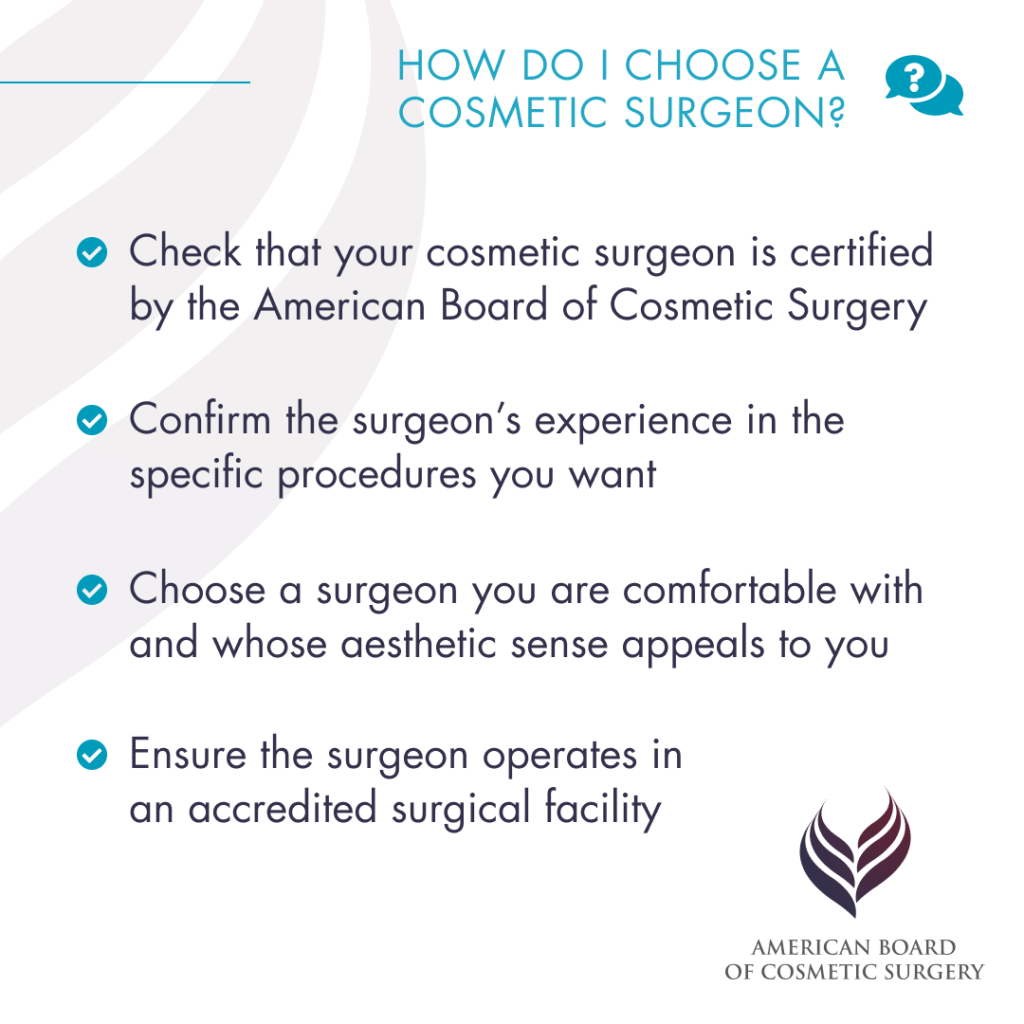
Which filler do I need?
With so many dermal filler products on the market, it can be difficult to know which option is best for you without an experienced cosmetic surgeon’s guidance. Each product is uniquely formulated to have a certain texture, density, and injection depth, which means that certain fillers work better for certain areas of concern. While your provider will determine what product is best for you, the following diagram illustrates in general where cosmetic surgeons tend to apply certain products:
What to Expect During Treatment
Dermal filler injections are non-surgical and typically completed during an office visit. Your initial treatment will begin with a consultation, during which you will meet with your cosmetic surgeon to discuss your concerns and goals.
Pre-treatment consultation
During your consultation, your cosmetic surgeon will evaluate your area of concern and review your medical history. While the risks associated with dermal fillers are minimal, you need to fully disclose your medical history prior to treatment, as certain allergies, skin and neurological conditions, or medications can jeopardize your safety or results. For instance, you need to tell your cosmetic surgeon if you have been taking NSAIDs (e.g., aspirin, ibuprofen, naproxen) or blood thinners, as these increase the likelihood of bruising.
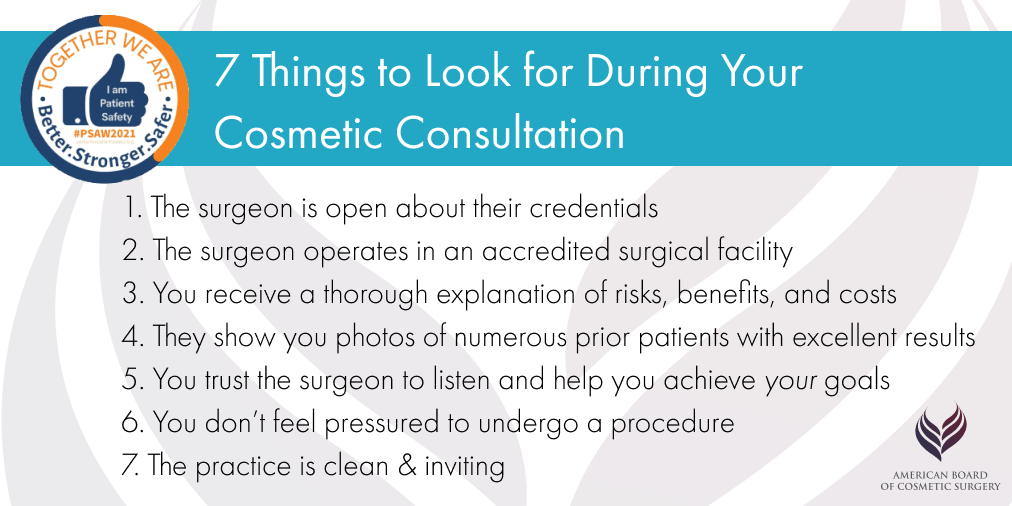
Your injectable filler treatment
Just before the actual treatment, the area will be cleaned, and you may be given a topical anesthetic to numb the area prior to injection. Many filler products also contain lidocaine, a mild anesthetic, which is intended to help minimize discomfort during and after your treatment. Your provider will then inject a precise amount of filler strategically beneath the skin.
Depending on the product and the areas treated, you should be able to notice results immediately after receiving filler injections. Some patients experience mild bruising and swelling, but these are temporary and should subside over the days following treatment. You will be able to go back to your normal activities right after treatment, but your cosmetic surgeon may ask you to take the day off from exercise or other strenuous activity.
If you are having fat injections…
Facial fat grafting is a surgical procedure and follows a different treatment protocol. Typically, fat grafting is performed as an outpatient procedure, using general anesthesia or local anesthesia with sedation. Up to 2 weeks of downtime may be required, depending on the extent of liposuction performed. Your cosmetic surgeon will go over what to expect with surgery and recovery during your consultation.
How Long Do the Results Last?
How long the effects of dermal fillers will last depends on the product, the area of treatment, and the patient. Generally speaking, the denser the product is and the more deeply it is injected, the longer it will last, although this is not a hard and fast rule. To maintain your results, your cosmetic surgeon will simply repeat treatment, adjusting the amount and techniques as necessary to ensure optimal results.
Hyaluronic acid fillers tend to be the most temporary option, and therefore are often recommended for first-time filler patients. These will typically last from 6 to 18 months. Injections to the lips will wear out a little faster than those to the nasolabial folds. Certain HA fillers, such as VOLUMA, are formulated to last longer, but are usually limited to certain areas, such as the cheeks.
Synthetic fillers tend to last longer, as they are not absorbed by the body. They can be a great option for the right patient, but you’ll want to be ready to commit to results that will be there for several years—and choose an experienced, qualified provider whose aesthetic style you like.
Fat injections are meant to last indefinitely; however, some of the injected fat is expected not survive. Initially, your cosmetic surgeon may overfill the treatment area, resulting in an initially fuller look that will gradually settle into a more natural appearance.
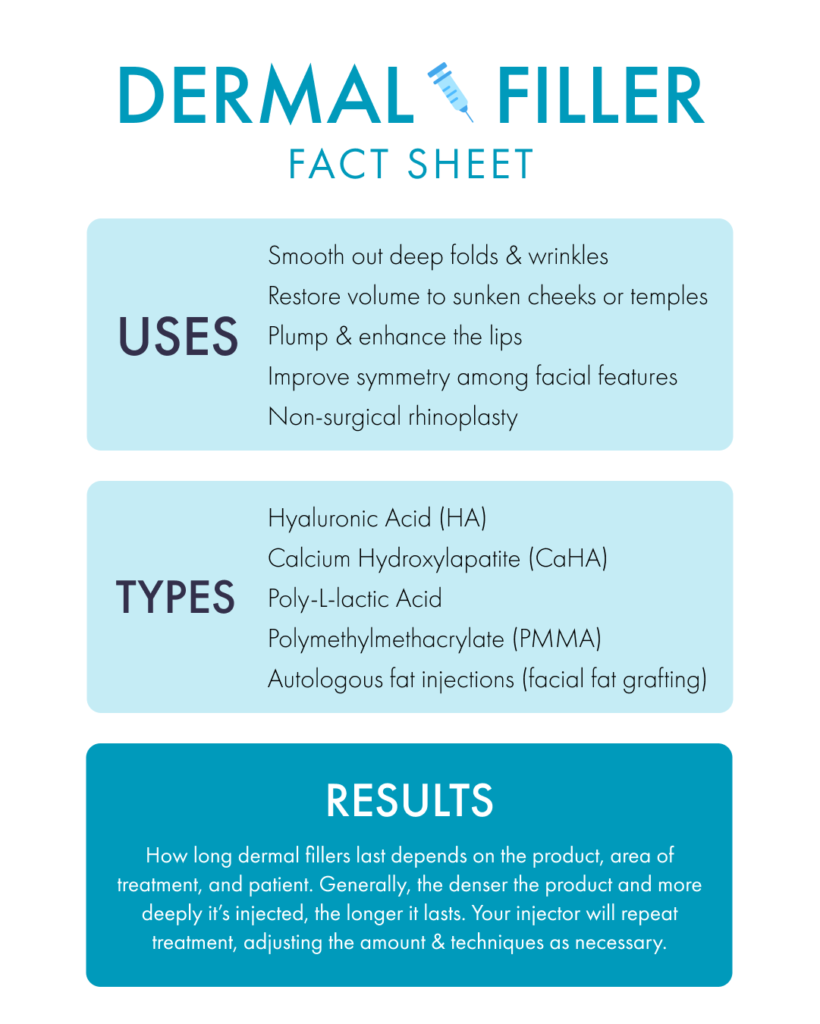
Find a qualified dermal filler provider near you
With the help of an experienced, qualified provider, injectable fillers can provide natural-looking enhancements to help you feel more confident in your appearance. If you’re ready to learn more about your options, the next step is to meet with a board certified cosmetic surgeon for a consultation. You can use our ABCS Find-a-Surgeon tool to locate a cosmetic surgeon near you.
References »
Mehta-Ambalal SR. Neocollagenesis and Neoelastinogenesis: From the Laboratory to the Clinic. Journal of Cutaneous Aesthetic Surgery. 2016. doi: 10.4103/0974-2077.191645
Hamman MS, Goldman MP. Minimizing bruising following fillers and other cosmetic injectables. The Journal of Clinical and Aesthetic Dermatology. 2013 Aug;6(8):16-8. PMID: 24003345; PMCID: PMC3760599.
Khosravani N, Weber L, Patel R, Patel A. The 5-Step Filler Hand Rejuvenation: Filling with Hyaluronic Acid. 2019. doi: 10.1097/GOX.0000000000002073.
Kapoor KM, Saputra DI, Porter CE, Colucci L, Stone C, Brenninkmeijer EEA, Sloane J, Sayed K, Winaya KK, Bertossi D. Treating Aging Changes of Facial Anatomical Layers with Hyaluronic Acid Fillers. 2021. doi: 10.2147/CCID.S294812.
Papakonstantinou E, Roth M, Karakiulakis G. Hyaluronic acid: A key molecule in skin aging. Dermato-Endocrinology. 2012 Jul 1;4(3):253-8. doi: 10.4161/derm.21923. PMID: 23467280; PMCID: PMC3583886.
